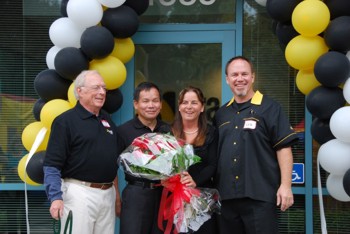Xradia's Technology Provides Views of Structures Never Seen Before
Xradia's Technology Provides Views of Structures Never Seen Before

X-Ray Microscopes Allow for Non-Destructive Viewing of Intricate Objects
"If you could see anything, what would you look for?"
This is one of the thought-provoking questions Xradia poses to customers, primarily industrial specialists and researchers who are "pushing the frontiers of science," according to Rod Browning, CEO of the company that celebrated both its 10th anniversary and its arrival in Hacienda last month.
"We make the world's best X-ray microscopes," Browning remarks, explaining that Xradia systems are based on proprietary optics and detector technologies that enable users to peer into samples without having to destroy them, so they can view interior structures and parts of items of interest that they have never been able to see before.
"The non-destructive capability is a stand-out for many industries, such as in semiconductors, where it is used to characterize a chip package or provide analysis of a failure," he relates. "The very act of cutting a chip can change its structure. We are able to provide analysis without destroying it."
Another ground-breaking hallmark is the unprecedented resolution Xradia equipment delivers. "We use X-rays instead of visible light to generate resolution levels from the micron level down to 50 nanometers," says Browning. "This allows us to nondestructively produce 3D images of objects with exceptional spatial resolution and contrast, so researchers see structures more clearly."
Application segments extend far beyond the semiconductor arena, an early market for the company. Its imaging products enjoy wide acceptance in the industrial and scientific research communities, with nearly 100 installations at synchrotron and lab facilities, including such premier sites as the local Stanford National Accelerator Laboratory and Lawrence-Berkeley National Laboratory.
"Xradia's 3D imaging products have been implemented successfully in biomedical and life science research, rock physics modeling for oil and gas exploration, nano-imaging applications, and advanced material development and characterization," Browning adds. They have also played a pivotal role in the analysis of geological artifacts, most notably in the study of "Lucy," the three-million-year-old hominid skeleton discovered in Ethiopia in 1974.
Previously spread out among multiple sites in the northeast corner of the Bay Area, Xradia was spurred by continuing growth and expiring leases to consolidate operations in one physical location, improving not just efficiencies but also access to engineering and sales and marketing talent. With its proximity to BART and the 580/680 corridor, Hacienda has "all the amenities we're looking for," Browning notes.
Still privately held, with funding from Intel Capital, among other investors, the company moved its entire workforce of just under 90 people to a new, 37,000 square foot global headquarters at 4385 Hopyard Road in October. "In addition to management, marketing, HR, and the traditional corporate structure, we have complete engineering, design, and manufacturing for distribution to our customers globally, including China," Browning reports. The facility also features a state-of-the-art imaging center for customer demonstrations "to enable them to understand the full range of capabilities we bring to their applications."
For more information, visit www.xradia.com.
Also in this issue...
- Xradia's Technology Provides Views of Structures Never Seen Before
- Junction Solutions Offers Innovative ERP Solutions for Retail, Food/Beverage Industry
- Business Bits
- Executive Profile: Tom Rowe, State Compensation Insurance Fund
- Fast Growth Helps EASi Make the Inc. 5,000 List
- PortableOne.com Stands Out Among Mobile Computing Vendors
- Hacienda Retail and Service Directory
- Rotary Clubs Brighten the Holidays
- 511 Rideshare Offers Special Incentives for New Carpoolers
- Child Care Links Pediatric CPR Class Slated for December
- Hacienda Helping Hands
- Hacienda Index
- Calendar




